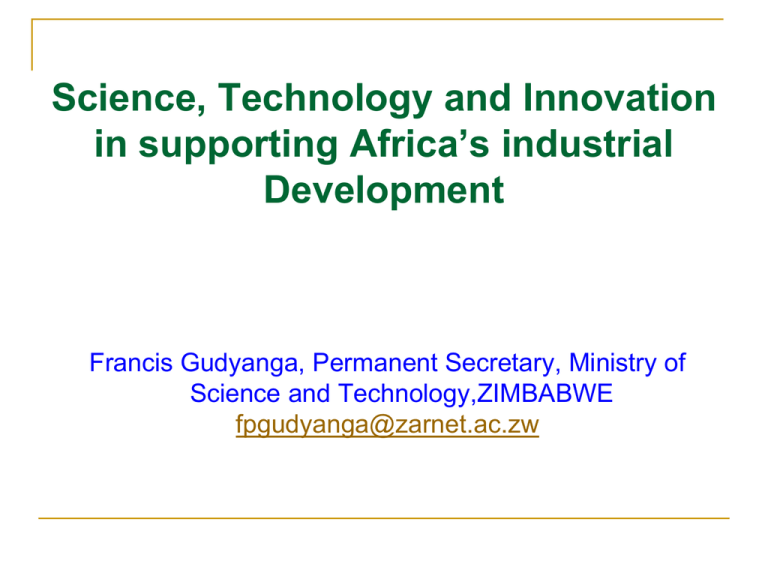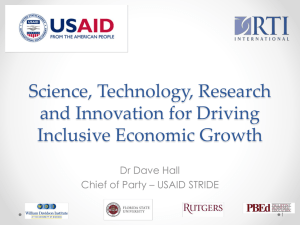Materials Research for Sustainable Development
advertisement

Science, Technology and Innovation in supporting Africa’s industrial Development Francis Gudyanga, Permanent Secretary, Ministry of Science and Technology,ZIMBABWE fpgudyanga@zarnet.ac.zw Outline of Presentation Introduction Review of the CODIST II Concept Note Paper Review of the CODIST II Keynote Speech Africa’s performance on some global STI Indicators Africa’s Comparative Advantages Lessons for Africa from other regions Africa’s options/imperatives Recommendations INTRODUCTION Modern industrial development requires know-how and capacity to adopt, disseminate, and implement science and technology for practical uses. Many African countries associated with natural resources and raw materials. Even with this comparative advantage, except for South Africa, most of the economies have either stagnated or grown slowly. Building S&T capacity requires investment in R&D which must compete with other spending priorities of the state; nonetheless, STI are indispensable tools for achieving these other priority objectives. COSTID II 2011 is timely to reinforce the importance of STI to industrial development Africa is not completely homogenous; there are disparities between different countries and regions in the continent. Three groups in terms of technological advancement: South Africa, North Africa, Sub-Sahara Africa Differences between African countries minor compared to disparities between Africa and other regions. Challenges and opportunities throughout the continent are similar. Throughout this presentation Africa will be presented as one. Review of the CODIST II Concept paper Well researched and referenced Balanced Sets the right scene Reminds us of previous declarations by African governments on the importance of STI Notes that declarations not matched with requisite financial allocations to STI programmes REVIEW OF THE KEYNOTE SPEECH Well structured paper Broad overview of the status of STI in Africa Information of the WB and ADB North Africa grouped with Middle East Manufacturing picked as an illustrative case to characterise Africa’s industialisation Competitive Industrial Performance Index (CIP), the Global Competitive Index (GCI) and the Knowledge Economy Index (KEI) used for comparative analysis. The paper picks also Tunisia in Africa for detailed comparison with India and Malaysia and draw lessons for the rest of Africa. The paper arrives as the same conclusion as arrived at using other set of indicators. The conclusion is that Africa’s industrial performance is dismal. The paper gives detailed definitions of Innovation and the complex National Innovations Systems to assist policy makers to understand these concepts with a view to making informed policy decisions. On STI the paper recommends investment in extensive training and research as necessary steps toward transforming the continent into a knowledge society. He wisely recommends concentrating the limited resources towards well targeted research. Indicators of the Technology Achievement Index (TAI) Type of Indicator Indicator Patents Creation of Technology Royalties Internet Diffusion of recent Exports innovation Telephones Diffusion of old innovations Electricity Schooling Human Skills University TAI Ranking of 67 selected countries Leaders Potential Leaders Dynamic Adopters Marginalised TAI: > 0.5 TAI: 0.35-049 TAI: 0.2-0.34 TAI: <0.2 17 countries 15 countries 26 countries 8 countries No African country No African country 5 African countries 6 African countries This group is at the cutting edge of technological innovation Technology diffusion and skill building have a long way to go; Most African countries belong to this group Most of these countries have invested in high levels of human skills; have diffused old technologies widely Countries are dynamic in the use of new technologies; most are developing countries with important hightech industries. Region World High Tech High Tech Imports Exports GERD as % of GDP Researchers Publications Patents GDP 100.0 100.0 100.0 100.0 100.0 100.0 100 America 21.4 17.7 37.9 25.4 35.3 43.2 31.3 Europe 34.2 36.0 27.4 29.5 42.5 27.8 29.0 Africa 1.4 0.3 0.9 2.2 2.0 0.1 3.9 41.7 45.8 32.2 40.9 30.7 31.9 34.5 1.3 0.2 1.6 2.0 3.4 1.8 1.4 Asia Oceania Ranking of regions by the above indicators 1 2 3 4 5 Asia Europe Americas Africa Oceania Asia Europe Americas Africa Oceania Americas Asia Europe Oceania Africa Asia Europe Americas Africa Oceania Europe Americas Asia Oceania Africa America Asia Europe Oceania Africa Asia Americas Europe Africa Oceania Imports Exports GERD Researchers Publications Patents GDP Indicators point to Africa’s Poverty Food insecurity Diseases Poor infrastructure Industrial stagnation etc HDI: Composite measure of health, education and income AFRICA’S COMPARATIVE ADVANTAGES Natural Resources African oil Minerals Fresh water – Lake Victoria, Lake Volta, Kariba Dam Oceans – Atlantic and Indian Oceans Hydroelectric value Fishing, mining and offshore oil drilling Human capital “Take it back: Europe’s new auto recycling laws,” – Stephen Power, p. W15, WSJE (April 21-23, 2006) Automakers required to “recycle 85% of a vehicle by weight, rising to 95 % in 2015” “Automakers are increasingly using synthetic materials, such as reinforced plastics, to lower the vehicle weight and emissions. Those materials are much harder to recycle than conventional non-synthetic materials” DaimlerChrysler….has begun building Mercedes-Benz cars with exteriors made partly of a type of banana-plant fiber that is both more biodegradable and lighter than exteriors made from conventional glass fibers” Resource Curse “Almost without exception, the resource-abundant countries have stagnated in economic growth since the early 1970s, inspiring the term, ‘curse of natural resources’. Empirical studies have shown that this curse is a reasonably solid fact…..Except for the direct contribution of the natural resource sector itself, …natural resource abundant countries systematically failed to achieve strong export led growth or other kinds of growth” - Sachs and Warner, European Economic Rev., 45, 827-838 (2001) Resource Curse “Economic growth since 1965 has varied inversely with the share of natural capital in national wealth across countries….” “Natural capital appears to crowd out human capital, thereby slowing down the pace of economic development” “..nations that believe that natural capital is their most important asset may develop a false sense of security and become negligent about the accumulation of human capital” - Gylfason, European Economic Rev., 45, 847859 (2001) Minerals and Africa’s Knowledge Economy Can “large-scale investments in exploration, transportation, geological knowledge, and the technologies of extraction, refining, and utilization” help to transform Africa’s minerals sector into “a leading edge of the knowledge economy” in the continent? Challenge: Sustainable Development via Export of Unprocessed Metal Ores? 10000000 1000000 Discovery 100000 Copper, Gg 10000 Extraction 1000 100 Copper; after Gordon et al., Proceed. Nat. Acad. Sci., 103, 1209 (2006) 10 1 1750 1800 1850 1900 Year 1950 2000 2050 Leveraging natural resources African cartels of commodities Platinum, diamond, cobalt, chromite, coffee, etc Funding capacity building and R&D in exchange for access to natural resources University infrastructure,chairs and scholarships R&D centres and programmes Lessons from China and India China: more traditional labour intensive export strategy India: a new knowledge intensive service export strategy Traditional Industrial policies from both China and India Protection of infant industries Direct state ownership Selective credit allocation Favourable tax treatment to specific industries Tariff and non-tariff barriers to imports Restrictions on FDI Local content requirements Special IPR policies Government procurement Promotion of large domestic firms SMEs: reserved by law certain products Massive investment in Higher Education Lessons from India and China (cont.) Modern industrial policies Strategies for tapping into global knowledge: Trade, FDI, technology licensing, copying and reverse engineering, foreign education and training, accessing information in print and internet, large market pull, Technology parks to attract diaspora; Increased spending in R&D for MNCs to do R&D locally MNCs setting up R&D centres for developing products for global markets Cost-effectiveness: hiring relatively low-wage scientists and engineers Lessons from India and China (Cont.) Africa’s challenges not experienced by India & China Economies of scale - large domestic markets Competitive low labour-intensive export products Africa not integrated yet into global supply and distribution chains through MNCs and vast diaspora India and China now exporting technology intensive goods Africa’s other challenges Tighter international trade regulations Pressure to reduce tariff and non-tariff barriers – GATT Stronger rules about subsidies and other indirect support to special industries Stronger teeth to enforce IPR regulations Market economy much more global market No economies of scale in purchasing, branding, advertising and distribution No critical mass of highly educated professionals to power rapid move up the technology ladder Africa’s action in support of STI-led industrial development Political level Political commitment and leadership of STI Informed STI policies Policy consistencies Industrial/trade policy interventions in support of STI Harmonisation of national policies to bring better integration of cross-cutting STI policies Act in concert at regional and continental level Economies of scale; cartels on commodities Action Africa need to take (cont.) Investment in education Primary education Secondary education – science biased curiculum Higher Education – strongly oriented towards the acquisition of knowledge, reinforcement of critical skills; central to the knowledge society Postgraduate and doctoral studies Meaningful and serious innovations to meet global challenges PhD holders needed to train the next generation of scientists and engineers Action Africa need to take (cont.) Massive investment in R&D 1% GERD over GDP Niche areas and/or emerging technologies where there are prospects of leapfrogging Materials research – nanotechnology Biotechnology ICT Renewable energy etc Materials Research Capitalising on Africa’s natural resources Need to develop locally suited materials Africa Materials Research Society (AMRS) Formed in 2002 in Daka, Senegal A NEPAD flagship programme under the Consolidated Plan of Action Developing materials research capacity in Africa The only continental body of professionals dedicated to the research on materials AMRS Conferences 2003 South Africa 2005 Morocco 2007 Tanzania 2009 Nigeria 2011 Zimbabwe Africa-MRS Conference in Victoria Falls 11-16 December 2011 www.africamrs.co.za Themes for the AMRS conference 2011 Materials Education and Networking Nanomaterials and Nanotechnology Basic Sciences of Materials Materials for Energy and Sustainability – fuel cells Infrastructure materials (cement and concrete) Raw materials beneficiation and Mineral processing Materials for Life, Health and the Environment Frontiers of Materials Research RECOMMENDATIONS Political commitment and leadership on STI Investment in education: (attentions to PhDs) Investment in R&D Industrial/trade intervention policies African cartels on commodities Support of STI in exchange of Access to resources Commitment to 1% of GDP Research in niche areas Support for African-MRS (a CPA flagship) THANK YOU








